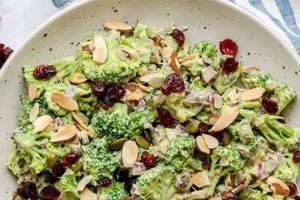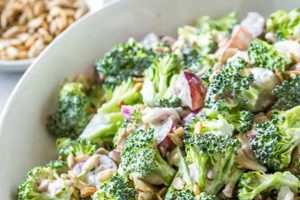A combination of raw or blanched broccoli and cauliflower florets forms the base of this salad, often enhanced with other fresh vegetables like carrots, bell peppers, and red onion. A creamy dressing, frequently mayonnaise-based with additions like vinegar, herbs, and spices, binds the ingredients. Variations might include dried fruits, nuts, seeds, or cheeses for added flavor and texture.
This type of salad offers a nutritious and convenient meal option. Cruciferous vegetables like broccoli and cauliflower are rich in vitamins, minerals, and fiber, contributing to a healthy diet. The customizable nature of the salad allows for adjustments to dietary preferences and seasonal ingredient availability. Its relative ease of preparation also makes it a popular choice for quick lunches, potlucks, or side dishes.
This article will further explore specific ingredient combinations, dressing variations, preparation techniques, and tips for creating a delicious and visually appealing cruciferous vegetable salad. Nutritional information and potential health benefits associated with these ingredients will also be discussed.
Tips for a Delicious Cruciferous Salad
Achieving optimal flavor and texture in a broccoli and cauliflower salad requires attention to several key preparation techniques.
Tip 1: Blanching for Optimal Texture: Briefly submerging broccoli and cauliflower florets in boiling water, followed by an immediate ice bath, helps maintain a crisp texture and vibrant color while reducing strong flavors.
Tip 2: Dressing Consistency: A balanced dressing, neither too thick nor too thin, ensures even coating and prevents the salad from becoming soggy. Whisking ingredients thoroughly emulsifies the dressing for optimal consistency.
Tip 3: Flavor Balancing: A harmonious blend of flavors is crucial. Acidity from vinegar or lemon juice complements the subtle sweetness of dried fruits or the savory notes of cheeses and nuts.
Tip 4: Ingredient Uniformity: Cutting vegetables into similar sizes promotes even cooking and distribution of flavors within the salad.
Tip 5: Freshness is Key: Using fresh, high-quality produce ensures the best flavor and nutritional value. Look for firm, brightly colored broccoli and cauliflower heads.
Tip 6: Proper Storage: Storing the salad in an airtight container in the refrigerator helps maintain freshness and prevents absorption of unwanted odors.
Tip 7: Customization: Adapting the recipe with preferred ingredients adds a personal touch. Consider roasted vegetables, different cheeses, or a variety of nuts and seeds.
By following these tips, one can create a flavorful and visually appealing salad that maximizes the nutritional benefits of these cruciferous vegetables.
These guidelines offer a foundation for crafting a delightful and nutritious salad, paving the way for culinary exploration and enjoyment.
1. Fresh Ingredients
Ingredient freshness significantly impacts the overall quality of a simple broccoli cauliflower salad. Fresh produce offers optimal flavor, texture, and nutritional value. Broccoli and cauliflower should exhibit vibrant color, firm florets, and a crisp texture. Wilted or discolored vegetables can impart off-flavors and compromise the salad’s appeal. Using fresh ingredients elevates the simple salad from basic to exceptional, enhancing the enjoyment and health benefits derived from this dish.
Consider the contrast between freshly harvested broccoli, with its crisp texture and subtle sweetness, and broccoli that has been stored for an extended period, resulting in a softer texture and potentially bitter notes. This difference becomes even more pronounced in a raw salad where the vegetables are not cooked to potentially mask declining quality. Freshness extends beyond the main vegetables; other components, such as herbs, red onion, and any additional produce, contribute to the overall vibrancy and flavor when sourced fresh. The dressing, if made with fresh lemon juice or herbs, will also exhibit a brighter, more pronounced flavor profile.
Prioritizing fresh ingredients not only enhances the sensory experience but also maximizes the nutritional benefits. Vitamins and antioxidants are often more potent in freshly harvested produce. Selecting and preparing fresh ingredients, while a seemingly simple step, plays a crucial role in optimizing both the taste and healthfulness of this simple salad. Careful attention to ingredient quality transforms a basic recipe into a vibrant and nutritious culinary experience.
2. Balanced Dressing
A balanced dressing is crucial for a simple broccoli cauliflower salad recipe. It elevates the combined flavors of the vegetables and other components without overpowering their individual characteristics. A well-executed dressing provides a cohesive element, binding the ingredients together while enhancing the overall sensory experience. The balance refers to the harmonious interplay of flavors sweet, sour, salty, and sometimes spicy creating a dressing that complements rather than masks the fresh produce.
- Acidity
Acidity, often from vinegar or citrus juice, provides a brightness that cuts through the richness of the vegetables and other ingredients. Lemon juice offers a clean, citrusy tang, while apple cider vinegar contributes a subtle sweetness and complexity. The appropriate level of acidity prevents the salad from tasting bland, adding a refreshing dimension. For example, a dressing with too little vinegar might taste flat, while excessive vinegar can overwhelm the other flavors. Careful adjustment of acidity is essential for achieving a well-balanced dressing.
- Sweetness
A touch of sweetness balances the acidity and adds depth to the dressing. This can be achieved through ingredients like honey, maple syrup, or even a pinch of sugar. A small amount of sweetness rounds out the flavor profile, preventing the dressing from being overly tart. For example, a honey-mustard dressing uses the sweetness of honey to complement the sharpness of mustard. The judicious use of sweeteners ensures a harmonious flavor profile.
- Creaminess/Oil
The creamy or oily component of the dressing provides a textural element that coats the vegetables and other ingredients, allowing the flavors to meld. Mayonnaise creates a rich, creamy dressing, while olive oil offers a lighter, more delicate coating. This element contributes to the overall mouthfeel and prevents the salad from being dry. For example, a classic mayonnaise-based dressing provides a creamy coating that clings to the vegetables, distributing flavor evenly. Alternatively, a vinaigrette-based dressing with olive oil provides a lighter, more refreshing texture.
- Seasoning
Seasoning enhances the overall flavor profile of the dressing and the entire salad. Salt and pepper are essential, while additional herbs and spices can add complexity. Fresh or dried herbs like dill, parsley, or chives can complement the vegetables. Spices such as garlic powder or onion powder can add savory notes. For example, a dressing with fresh dill and a pinch of garlic powder adds a bright, herbaceous element. Proper seasoning elevates the dressing beyond its basic components, creating a more nuanced and flavorful experience.
The careful balance of these elements creates a dressing that enhances the simple broccoli cauliflower salad. Each component plays a distinct role, contributing to the overall flavor profile and texture. A well-balanced dressing transforms the individual ingredients into a cohesive and satisfying dish. The interplay of acidity, sweetness, creaminess, and seasoning elevates this simple salad to a more complex and enjoyable culinary experience.
3. Crisp Texture
Crisp texture is a defining characteristic of a successful simple broccoli cauliflower salad. It contributes significantly to the overall sensory experience, offering a refreshing contrast to the creamy dressing and other potentially softer ingredients. This textural element elevates the salad beyond a simple mix of ingredients, providing a dynamic interplay between contrasting textures. Consider the difference between biting into a crisp floret of broccoli versus one that has become softened or soggy. The former offers a satisfying crunch, while the latter can detract from the overall enjoyment of the salad.
Several factors influence the crispness of the vegetables. The freshness of the produce is paramount. Broccoli and cauliflower that have been stored for extended periods tend to lose their crispness. Proper preparation techniques, such as brief blanching followed by an immediate ice bath, help maintain the desired texture. Overcooking or improper storage can lead to a loss of crispness. The choice of dressing also plays a role. A heavy, overly creamy dressing can soften the vegetables over time, while a lighter vinaigrette is less likely to compromise the crisp texture. Incorporating ingredients such as dried fruit or nuts should be done judiciously to avoid introducing excessive moisture that could soften the vegetables.
Maintaining crisp texture is essential for optimizing the enjoyment of this simple salad. It provides a refreshing counterpoint to the other flavors and textures, enhancing the overall sensory experience. Achieving this desired crispness requires careful attention to ingredient selection, preparation methods, and dressing choice. The reward is a salad that is not only flavorful but also texturally appealing, offering a satisfying culinary experience.
4. Flavorful additions
Flavorful additions transform a simple broccoli cauliflower salad from basic to exceptional. While the core ingredients of broccoli and cauliflower provide a nutritious base, supplemental components contribute depth, complexity, and textural variety. These additions, ranging from dried fruits and nuts to seeds, cheeses, and herbs, elevate the salad’s sensory profile, offering a more nuanced and satisfying culinary experience. The considered inclusion of such elements distinguishes a truly remarkable salad from a merely adequate one.
Consider the impact of toasted sunflower seeds. Their nutty flavor and satisfying crunch contrast with the softer textures of the broccoli and cauliflower, creating a more dynamic and engaging experience. Similarly, the addition of dried cranberries introduces a touch of sweetness and chewiness, complementing the savory notes of the vegetables and dressing. Crumbled feta cheese contributes a salty, tangy dimension, further enhancing the complexity of the salad’s flavor profile. Fresh herbs, such as dill or parsley, offer a bright, herbaceous counterpoint, adding a refreshing element to the overall composition. Even a simple addition like toasted slivered almonds can significantly enhance the salad’s aroma and textural appeal. These additions, while seemingly minor, collectively contribute to a more sophisticated and enjoyable salad.
Strategic incorporation of flavorful additions is essential for maximizing the potential of a simple broccoli cauliflower salad. The choice of additions should consider the overall flavor profile desired. A Mediterranean-inspired salad might benefit from the inclusion of Kalamata olives and crumbled feta, while a more classic approach might feature dried cranberries, sunflower seeds, and a creamy dressing. Careful consideration of flavor combinations and textural contrasts ensures a balanced and harmonious final product. Understanding the role and impact of these additions allows for the creation of a simple yet sophisticated salad that is both nutritious and deeply satisfying.
5. Easy Preparation
Ease of preparation is a key attribute of a simple broccoli cauliflower salad recipe, making it an appealing option for various occasions, from quick weeknight meals to potlucks and larger gatherings. Minimal cooking, straightforward procedures, and readily available ingredients contribute to the convenience of this dish. This aspect allows for efficient creation without compromising flavor or nutritional value, making it a practical choice for both novice and experienced cooks.
- Minimal Cooking Requirements
Many variations require no cooking at all, relying on raw broccoli and cauliflower florets. This eliminates the need for stovetop cooking or oven use, saving time and energy. Even when blanching is preferred for a slightly softer texture, the process is brief, involving a quick immersion in boiling water followed by an ice bath. This minimal cooking approach simplifies the preparation process, making it ideal for time-constrained individuals.
- Straightforward Procedures
The steps involved in preparing this salad are generally uncomplicated. Chopping vegetables, whisking together a dressing, and combining ingredients are typically the extent of the required actions. There are no complex techniques or specialized equipment necessary, making it accessible to a wide range of culinary skill levels. The simplicity of the process reduces the likelihood of errors, ensuring a consistently successful outcome.
- Readily Available Ingredients
Broccoli, cauliflower, and common dressing ingredients are typically readily available in most grocery stores year-round. This eliminates the need for specialized sourcing or extensive ingredient searches. The accessibility of these ingredients further streamlines the preparation process, making it a convenient option for impromptu meal planning.
- Adaptability and Customization
The simplicity of the recipe allows for easy adaptation based on individual preferences and available ingredients. Substitutions can be made without significantly altering the preparation process. For example, different vegetables, nuts, seeds, or cheeses can be incorporated based on dietary needs or personal tastes. This flexibility contributes to the long-term appeal of the recipe, preventing monotony and encouraging culinary creativity.
The ease of preparation associated with a simple broccoli cauliflower salad contributes significantly to its versatility and popularity. This characteristic makes it an accessible and convenient option for various meal occasions, simplifying healthy eating without sacrificing flavor or satisfaction. The combination of minimal cooking, straightforward procedures, readily available ingredients, and adaptability ensures that this salad remains a practical and enjoyable choice for a wide range of individuals.
6. Versatile Customization
Versatile customization is integral to the enduring appeal of the simple broccoli cauliflower salad recipe. This adaptability allows the basic formula to be tailored to individual preferences, dietary needs, and seasonal ingredient availability. The foundational combination of broccoli and cauliflower provides a neutral canvas for a wide range of additions, transforming a simple concept into a personalized culinary creation. This inherent flexibility contributes to the salad’s suitability for diverse occasions and palates.
- Dietary Adaptations
Customization allows for seamless integration of dietary restrictions. Vegan variations might substitute a plant-based mayonnaise or utilize a simple olive oil and lemon juice dressing. Gluten-free versions require attention to ingredient selection, ensuring all additions, such as croutons or dressings, are certified gluten-free. Low-carbohydrate diets might emphasize increased vegetable content and minimize additions like dried fruits. This adaptability ensures inclusivity and broadens the recipe’s appeal.
- Seasonal Variations
Seasonal produce can be incorporated to maximize flavor and nutritional value. Spring variations might include fresh asparagus and peas, while summer versions could feature ripe tomatoes and cucumbers. Autumnal adaptations might incorporate roasted butternut squash or pumpkin seeds, and winter versions could utilize dried cranberries and toasted pecans. This responsiveness to seasonal availability enhances the salad’s freshness and aligns with the natural rhythm of ingredient availability.
- Flavor Profile Adjustments
Flavor profiles can be adjusted based on personal preference. Those seeking a tangy profile might incorporate ingredients like chopped pickles or a Dijon mustard-based dressing. A preference for spicy flavors could be addressed with the addition of jalapeos or a sriracha-infused mayonnaise. A sweeter profile can be achieved by incorporating dried fruits or a honey-based dressing. This adaptability allows individuals to personalize the salad to their specific tastes.
- Textural Enhancements
Textural variety can be introduced through customized additions. Toasted nuts and seeds, such as sunflower seeds, almonds, or pumpkin seeds, provide a satisfying crunch. Crispy bacon bits or crumbled cooked chicken can add protein and textural contrast. Roasted chickpeas offer a hearty and flavorful addition, while dried fruits contribute a chewy element. This customization ensures a dynamic sensory experience beyond the basic textures of broccoli and cauliflower.
The versatility of the simple broccoli cauliflower salad recipe contributes significantly to its enduring popularity. This adaptability, reflected in dietary accommodations, seasonal variations, flavor profile adjustments, and textural enhancements, elevates the basic formula to a highly customizable dish suitable for a wide range of preferences and occasions. The capacity for personalization ensures continued enjoyment and integration into diverse culinary contexts.
Frequently Asked Questions
This section addresses common inquiries regarding broccoli and cauliflower salad preparation, offering practical solutions and clarifying potential uncertainties.
Question 1: How can one prevent the salad from becoming watery?
Excess moisture can accumulate from several sources, including undried vegetables and condensation within the storage container. Thoroughly drying all ingredients after washing and storing the salad in a well-sealed container can minimize water accumulation.
Question 2: What is the optimal method for blanching broccoli and cauliflower?
Blanching enhances color and reduces strong flavors while maintaining texture. Submerge florets in boiling water for 1-2 minutes, followed by immediate immersion in ice water to halt cooking. This method preserves crispness while optimizing flavor.
Question 3: Can frozen broccoli and cauliflower be used?
While fresh produce is generally recommended for optimal texture, frozen vegetables can be substituted. Ensure thorough thawing and draining before incorporating to minimize excess moisture. Adjust blanching time as needed.
Question 4: How long can the salad be stored?
Properly stored in an airtight container in the refrigerator, the salad typically maintains optimal quality for 3-5 days. However, the freshness of individual ingredients and the presence of added components like dressings can influence shelf life.
Question 5: What dressings complement this salad best?
Creamy dressings, such as mayonnaise-based options, or lighter vinaigrettes complement broccoli and cauliflower well. Flavor profiles can be customized with herbs, spices, or acidic components like vinegar or lemon juice to create diverse flavor combinations.
Question 6: Can this salad be prepared in advance for a large gathering?
Advance preparation is possible. Prepare the vegetables and dressing separately, combining them shortly before serving to maintain optimal texture and prevent the salad from becoming soggy. Certain additions, like nuts or dried fruits, can be incorporated just prior to serving to preserve their individual textures.
Addressing these common inquiries provides a foundation for successful broccoli and cauliflower salad preparation, ensuring a satisfying culinary experience.
The following section offers a sample recipe to guide practical application of the information presented.
Simple Broccoli Cauliflower Salad Recipe
Exploration of the simple broccoli cauliflower salad recipe reveals a dish offering both nutritional value and culinary versatility. Freshness of ingredients, a balanced dressing, crisp texture, and flavorful additions contribute significantly to the overall quality and enjoyment. Ease of preparation and adaptability to various dietary needs and preferences further enhance the recipe’s appeal. Careful attention to these elements ensures a consistently satisfying and healthful culinary experience.
The simplicity of this recipe belies its potential for culinary creativity. Exploration of diverse flavor profiles, textures, and seasonal ingredients offers a pathway to personalized variations. This adaptability ensures the enduring relevance of the simple broccoli cauliflower salad recipe, allowing it to remain a vibrant and engaging component of a healthful and enjoyable diet.






